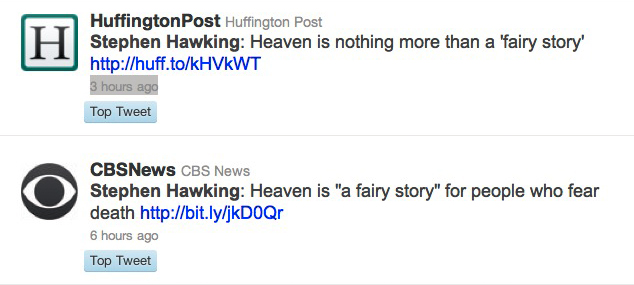A few minutes ago I saw Stephen Hawking trending on Twitter, clicked on the link, and found myself on the Twitter Search page, where the two top tweets from news organizations were these:
HuffPo’s link goes to a brief story with no links to any sources. I see there’s a tiny AP symbol next to the dateline. Does this mean it’s an AP story? I guess so, but the AP symbol is not linked to anything. So I go to the AP site, look it up, and sure enough: it is an AP story. Here’s the second paragraph:
In an interview published Monday in The Guardian newspaper, the 69-year-old says the human brain is a like a computer that will stop working when its components fail.
No link to the Guardian story there, either. Or to anything.
So I go to the CBS News tweet, and find the shortlink leads to this story, where the second paragraph reads,
In an interview published in the Guardian, Hawking – author of the bestselling “A Brief History of Time” – said that when the brain ceases to function, that’s it.
Kudos to CBS for linking to a source, and especially for breaking ranks with other news outfits that only (or mostly) link to their own stuff. The NYTimes and the Washington Post are two familiar offenders, but not-linking and self-linking are the norms. (Less so for Guardian, which has always been much farther ahead of the curve than other major papers. Blogs at the papers, such as Andrew Revkin’s, link generously. But these are exceptions to the rules that seem to govern the paper’s ink-based sections.)
On the whole, mainstream media have had a passive-aggressive approach to the Web ever since they were first challenged by it, in the mid-’90s. Even now, in 2011, they’re still trying to shove the Web’s genie back in the old ink bottle. They do it with paywalls, with schemes to drag your eyes past pages and pages of advertising, and (perhaps worst of all) by leaving out hyperlinks. Never mind that the hyperlink is a perfect way to practice one of journalism’s prime responsibilities: citing sources. Or, by another verb, attriibuting.
Maybe they take too seriously David Weinberger‘s “Hyperlinks subvert hierarchy” thesis (#7) in The Cluetrain Manifesto, and want to stay on (or crawl to the) top of whatever heaps they occupy.
The reasons I’ve usually heard for not linking, or for only linking to internal pages, is that the journal’s site “needs” to be “sticky,” to “drive traffic” past ads, and to maximize the time spent by readers on the site. (Nobody defends the tracking of readers.) Whatever the rationale, not-linking compromises an online journal’s editorial mission — especially if not-linking is policy and not just habit. (I think, for example, that with Fast Company it’s policy. For example, all the links in this story go to other Fast Company stories.)
So now I’m wondering if anybody has researched, or would be interested in researching, the practice of linking to sources by online journals — especially by mainstream news sites. Would this be a job for Media Cloud, I wonder? (I’ll bring it up with my friends there at the Berkman Center when I’m there tomorrow.)
[Later… ] see C.W. Anderson‘s comment below, which points to this Niemann piece by Jonathan Stray and this book by Joseph Turow and Lokman Tsui (a Berkman Center colleague who will receive the Gene Burd Urban Journalism Research Prize for the Best Dissertation in Journalism Studies here in Boston on the 27th of this month).
Also see what Kevin Anderson writes here, and the comments below. Excellent conversation, all around.

Leave a Reply